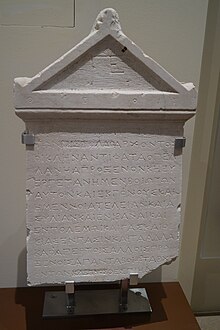| Ογχηστός | |
 | |
 | |
| Location | Boeotia |
|---|---|
| Region | Greece |
| Coordinates | 38°21′54″N 23°08′49″E / 38.364863°N 23.146959°E / 38.364863; 23.146959 |
| Type | City |
| History | |
| Periods | Ancient Greece / Rome |
Onchestos or Onchestus (Greek: Ογχηστός) was a Greek town in ancient Boeotia northwest of Thebes. In ancient times it was famous for its sanctuary of Poseidon. The site has been excavated intermittently since the 1960s. It was in the territory of Haliartus, said to have been founded by Onchestos, a son of Poseidon.
History
Onchestos is mentioned in the famous "Catalogue of Ships" in Homer's Iliad where it is referred to as Poseidon’s "bright grove." The town was a meeting place for the Boeotian League in the Macedonian period. The town was burned by the Persians under Xerxes I, and probably again by the Romans in 171 BC when nearby Haliartus was destroyed. In the early 1st century AD Strabo wrote that the temple was standing although Poseidon's sacred grove was "devoid of trees". In the 2nd century Pausanias wrote that he was still able to see Poseidon’s temple, cult image, and grove.
Archaeology
Its site is located near modern Steni. Sporadic archaeological excavations have taken place at the site from the 1960s onwards. Since 2014 a new Onchestos Excavation Project has begun to systematically examine the site. The excavations attest to sanctuary’s prosperity in the 6th and 5th centuries BC.
References
- Pausanias (1918). "26.5". Description of Greece. Vol. 9. Translated by W. H. S. Jones; H. A. Ormerod. Cambridge, Massachusetts; London: Harvard University Press; William Heinemann – via Perseus Digital Library.
- Stephanus of Byzantium. Ethnica. Vol. s.v.
- ^ Strabon, Geōgraphiká 9.2.33.
- Homer. Iliad. Vol. 2.506.
- ^ Stillwell, Richard; MacDonald, William L.; McAlister, Marian Holland (1976). The Princeton encyclopedia of classical sites. Princeton University Press.
- Richard Talbert, ed. (2000). Barrington Atlas of the Greek and Roman World. Princeton University Press. p. 55, and directory notes accompanying. ISBN 978-0-691-03169-9.
- Lund University. Digital Atlas of the Roman Empire.
![]() This article incorporates text from a publication now in the public domain: Smith, William, ed. (1854–1857). "Onchestus". Dictionary of Greek and Roman Geography. London: John Murray.
This article incorporates text from a publication now in the public domain: Smith, William, ed. (1854–1857). "Onchestus". Dictionary of Greek and Roman Geography. London: John Murray.
External links
- Onchestos Excavation Project, Columbia University
This article about a location in ancient Boeotia is a stub. You can help Misplaced Pages by expanding it. |